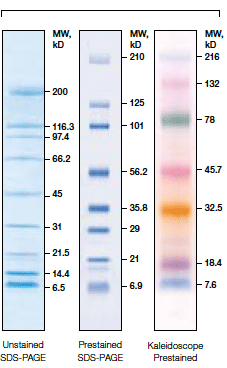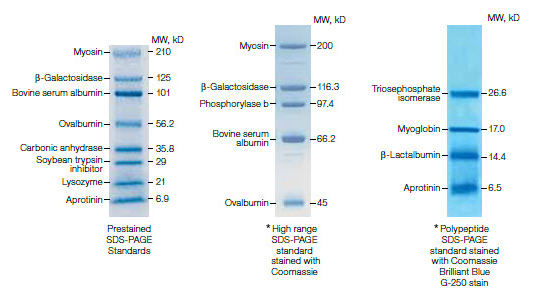Protein standards are mixtures of well-characterized natural or recombinant proteins that are loaded alongside protein samples in a gel. They are used to help monitor electrophoretic separation as well as estimate the size and concentration of the proteins separated in a gel. This section provides an overview of the different protein standards offered by Bio-Rad, their migration patterns and the range of molecular weight of proteins that can be used alongside these standards.
Related Topic: Protein Electrophoresis.
Page Contents
Select protein standards that offer:
- Good resolution of the proteins in the size range of interest
- Compatibility with downstream analysis (for example, blotting)
Protein standards are available as prestained or unstained sets of purified natural or recombinant proteins. Prestained standards allow direct visualization of the proteins' migration during electrophoresis and are useful to assess their subsequent transfer to membranes. Prestained standards can be used for size estimation, however unstained protein standards are recommended for the most accurate size determination.
Bio-Rad offers a full range of prestained and unstained standards for various applications. Details of Bio-Rad's protein standards are provided in the tables and figures below.
Applications of Bio-Rad's protein standards.
| Precision Plus Protein™ | Prestained Natural Standards | ||||||||||
 |
 |
 |
 |
 |
 |
 |
 |
 |
 |
 |
|
| Electrophoresis | |||||||||||
| Accurate MW estimation | • | • | • | • | • | • | • | — | — | — | — |
| Visualize electrophoresis | • | • | • | • | • | — | — | • | • | • | • |
| Orientation | • | • | • | — | • | — | — | — | — | — | • |
| Extended MW range | — | — | • | — | — | — | — | — | — | — | — |
| Coomassie staining | • | • | • | • | • | • | • | • | • | • | • |
| Fluorescent staining | — | — | — | — | — | • | • | — | — | — | — |
| Blotting | |||||||||||
| Monitoring transfer efficiency | • | • | • | • | • | — | — | • | • | • | • |
| Coomassie staining | • | • | • | • | • | • | • | • | • | • | • |
| Immunodetection | — | — | — | — | • | • | • | — | — | — | — |
| Fluorescent blots* | • | • | • | • | • | — | — | — | — | — | — |
MW = molecular weight.
* Not to be confused with fluorescent total blot stains. Precision Plus Protein prestained standards contain dyes with fluorescent properties. See bulletin 5723 for details on using precision Plus Protein WesternC standards for fluorescent multiplexing.
**Precision Plus Protein Standard Plugs are designed specifically for second dimension SDS-PAGE gels in 2-D experiments.
Bio-Rad's protein standards for western blotting applications.
Recombinant Precision Plus Protein Standards

Natural Standards

Protein standards for western blotting applications selection guide.
| Protein Standard | Type | Features | Molecular Weight Range (on Tris-HCl or TGX™ gels) |
 |
 |
 |
 |
 |
 |
| SDS-PAGE Unstained Standards (Natural) | Unstained natural | Protein blended to yield uniform band intensities upon staining | Broad: 6.5–200 kD High: 45–200 kD Low: 14.4–97.4 kD |
• | |||||
| Precision Plus Protein™ Unstained Standards | Unstained recombinant | Integrated Strep-tag for chemiluminescence visualization* | 10–250 kD | • | • | ||||
| Precision Plus Protein™ WesternC™ Standards | Prestained recombinant | Prestained multicolored fluorescent band with integrated Strep-tag for chemiluminescence visualization | 10–250 kD | • | • | • | • | • | |
| Precision Plus Protein Dual Color Standards | Prestained recombinant | Prestained multicolored fluorescent bands, 2-color band pattern | 10–250 kD | • | • | • | • | ||
| Precision Plus Protein Dual Xtra Standards | Prestained recombinant | Prestained multicolored fluorescent bands, 2-color band pattern, extended MW range | 2–250 kD | • | • | • | • | ||
| Precision Plus Protein™ Kaleidoscope™ Standards | Prestained recombinant | Prestained multicolored fluorescent bands, 5-color band pattern | 10–250 kD | • | • | • | |||
| Precision Plus Protein™ All Blue Standards | Prestained recombinant | Prestained fluorescent bands | 10–250 kD | • | • | • | |||
| SDS-PAGE Standards (Natural) | Prestained natural | Prestained fluorescent bands | Broad: 7.2–208 kD High: 47–205 kD Low: 19–107 kD |
• | • | ||||
| Kaleidoscope Prestained Standards (Natural) | Prestained natural | Prestained multicolored fluorescent bands, multicolored band pattern | 7.6–216 kD | • | • |
* For colorimetric or chemiluminescence blot detection, StrepTactin-HRP or -AP conjugate is also needed.
Recombinant standards are engineered to display specific attributes such as evenly spaced molecular weights or affinity tags for easy detection on western blots. Bio-Rad's recombinant standards are the Precision Plus Protein™ standards family of products and are available in stained or unstained formats (see figure below). These standards contain highly purified recombinant proteins with molecular masses of 10–250 kD (or 2–250 kD for the Dual Xtra standards).

Precision Plus Protein family of protein standards.
Unstained Standards
Unstained standards contain only purified proteins, so they do not exhibit the variability in molecular weight sometimes observed with prestained standards. Therefore, unstained standards or standards with affinity tags for blot detection deliver high molecular weight recommended for the most accurate molecular weight determinations for gels or blots.
- Precision Plus Protein unstained standards — include three high-intensity reference bands (25, 50, and 75 kD). These standards offer absolute molecular weight accuracy confirmed by mass spectrometry. Additionally, these standards are compatible with Laemmli and neutral pH buffer systems and are an excellent choice for use with the stain free technology (since they do not contain dye that can interfere with stain-free detection). See Protein Staining for more details.
- These standards contain an affinity StrepTactin, a genetically modified form of streptavidin. It is the high-affinity binding of the Strep-tag sequence to StrepTactin that allows convenient and simultaneous detection of both proteins and standards on western blots (see figure below) using either colorimetric or chemiluminescence methods.
Overview of the StrepTactin detection system 
Prestained Standards
The ability to visualize prestained standards during electrophoresis makes them ideal for monitoring protein separation during SDS-PAGE. The proteins are labeled with fluorescent dyes, so can be used in fluorescence detection applications. The prestained markers remain visible on the membrane after transfer, which makes them useful for monitoring transfer efficiency and the general location of antigens in repetitive screening assays (Tsang et al. 1984). Bio-Rad offers both recombinant and natural prestained standards.
- Precision Plus Protein prestained standards (All Blue, Dual Color, and Kaleidoscope™) — include a proprietary staining technology that provides batch-to-batch molecular mass consistency and reproducible migration. The ability to visualize these standards makes them ideal for monitoring protein separation during gel electrophoresis and monitoring transfer onto blotting membranes.
- Precision Plus Protein Dual Xtra standards — these prestained standards have additional 2 and 5 kD bands to enable molecular mass estimation below 10 kD.
- Precision Plus Protein WesternC standards — these standards were designed for western blotting applications. Having both unstained and prestained bands enables monitoring of electrophoresis, blot transfer and visualization of the standard after colorimetric or chemiluminescence development (when probed with StrepTactin-HRP or AP conjugate). The WesternC standard will appear directly on a film or CCD image. Additionally this protein standard has fluorescent properties that enable detection of fluorescent blots*
- Precision Plus Protein standard plugs — unstained Precision Plus proteins in a plug for easy loading onto second dimension gels (even those with no reference well).
*Prestained standards are not recommended for use on gels that will be stained with fluorescent dyes.
Natural standards are blended from naturally occurring proteins. Though effective for monitoring gel separation and transfer efficiency, prestained natural standards have an inherent variability in the amount and location of dye that covalently binds to the protein. This may produce broader bands than seen with recombinant standards, making them less desirable for molecular weight estimations.
Bio-Rad offers the following prestained and unstained natural standards:
- Kaleidoscope standards — individually colored proteins to allow instant orientation on gels and blots
- Prestained SDS-PAGE standards — blue colored standards available in low, high, and broad ranges
- Unstained SDS-PAGE standards — available in low, high, and broad ranges, these standards are blended to give uniform band intensities when stained with Coomassie Brilliant Blue R-250 or zinc stains. These standards can also be used for silver staining applications
- Polypeptide SDS-PAGE standards — for molecular weight determination of peptides and small proteins resolved on Tris-Tricine gels

* Can also be used with other staining applications such as silver staining.
Bio-Rad's natural protein standards.
